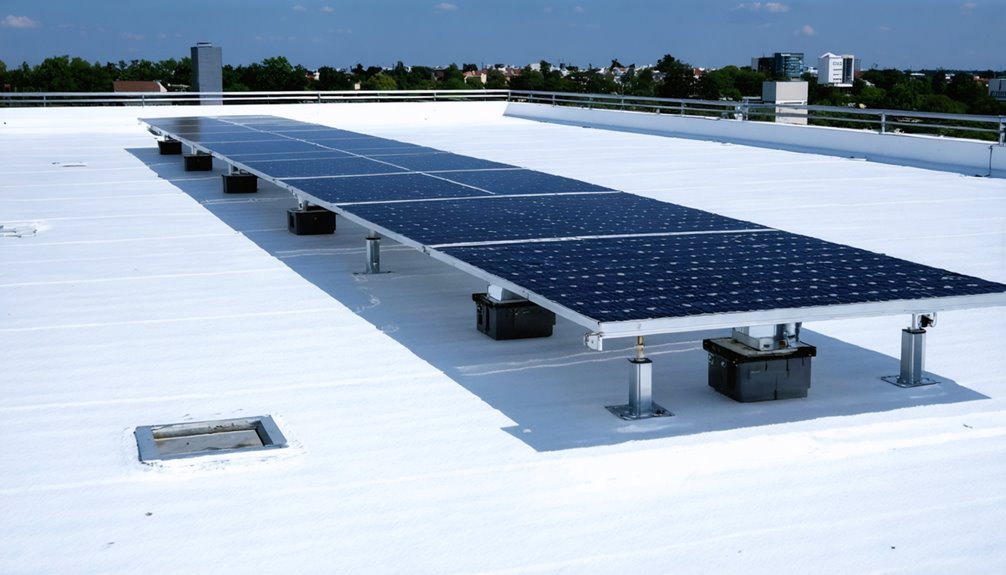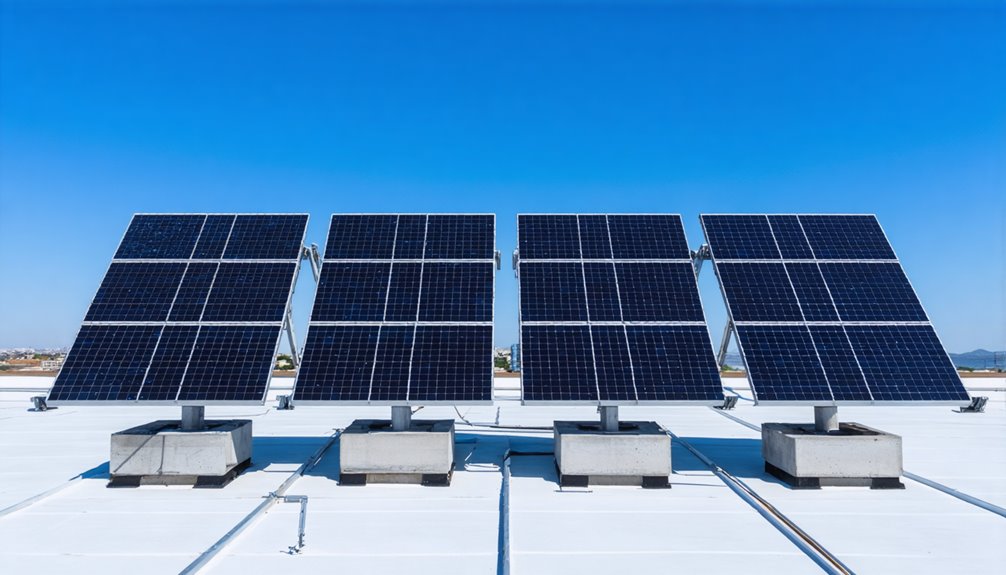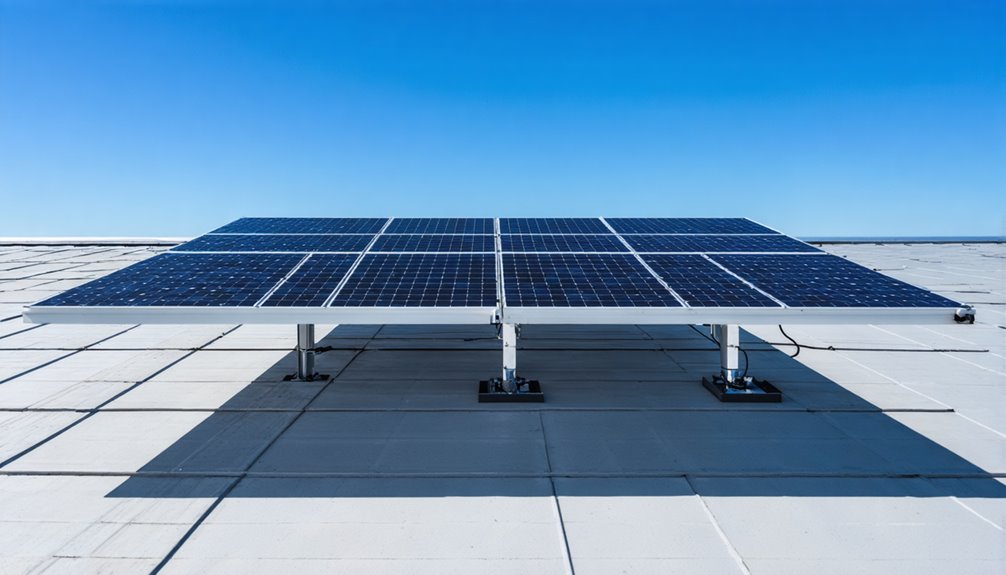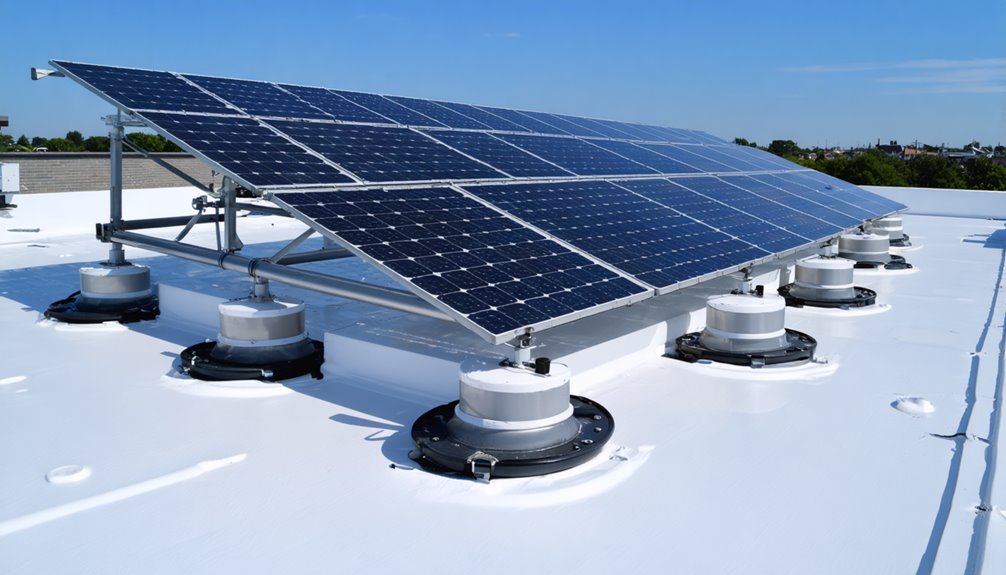To mount solar panels on a flat roof, you should use a non-penetrating ballast mount system. This method prevents leaks by utilizing heavy concrete blocks for stability without penetrating the roof. Confirm you conduct a structural assessment to verify wind load and weight tolerance. Additionally, take into account existing rooftop equipment for best panel placement. Tilted installations can enhance efficiency by facilitating snow clearance and drainage. Explore additional insights for a complete understanding of mounting strategies.
Overview of Flat Roof Solar Panel Installation
Mounting solar panels on a flat roof requires a specific approach that takes into account the unique structural and environmental challenges posed by this type of roofing. In flat roof mounting, you’ll need to carefully consider the arrangement to optimize solar exposure and avoid physical interferences. Non-penetrating mounting systems offer a low-risk option for many flat-roof installations non-penetrating systems. Prioritize proper weight calculations to guarantee the system withstands wind loads and structural stresses. Coordinating with existing rooftop equipment, like HVAC units, is essential. Secure anchoring methods such as through-bolting and rubber boots around support tubes improve stability and prevent leaks. Tilted installations can enhance efficiency, encouraging snow clearance and preventing water pooling, thereby improving electricity generation. Consequently, thorough planning is crucial to guarantee a successful solar panel installation on a flat roof.
The Ballast Mount Method Explained
When considering the ballast mount method for solar panel installation on a flat roof, you should understand how heavy concrete blocks provide stability without the need for roof penetrations, minimizing the risk of leaks and preserving the roof’s integrity. Accurate weight distribution and frame anchoring are essential, especially to address wind loads and ensure long-term stability. This method not only offers an effective alternative to traditional installation but also involves critical weight calculations to withstand wind loads and severe weather conditions. By guaranteeing that the concrete block stability is sufficient, you can assure the solar panels remain secure, maintaining both performance and cost-effectiveness.
Concrete Block Stability
Although traditional mounting methods often risk roof penetration, the ballast mount method provides a stable and non-invasive alternative for securing solar panels on flat roofs. This technique employs heavy concrete blocks, carefully distributed to counteract wind uplift and other environmental forces, maintaining the structural integrity of your roof while enhancing solar panel performance. Accurate weight calculations are essential to prevent system failure; improper distribution can either stress the roof or leave the system vulnerable. Regular assessments guarantee the ballast’s stability and compatibility with the roof’s load-bearing capacity.
| Consideration | Purpose |
|---|---|
| Weight Calculations | Prevent wind uplift |
| Ballast Distribution | Maintain stability |
| Ideal Tilt | Enhance sunlight exposure |
| Regular Assessments | Guarantee ongoing stability |
| Roof Inspection | Check load tolerance |
This method enhances clean energy generation without compromising roof integrity.
Roof Penetration Alternatives
Building on the importance of maintaining roof integrity while maximizing solar efficiency, the ballast mount method emerges as a preferred option for flat roofs, primarily due to its non-invasive nature. This method is the most common for flat roofs, effectively using heavy concrete blocks to secure solar panels without the need for roof penetrations. By minimizing penetration, you reduce the risk of leaks, preserving roof integrity. The ballast system’s weight must be calculated accurately to withstand wind forces, ensuring panels remain secure during severe weather. For smaller roofs where ballast isn’t sufficient alone, integrating permanent systems enhances stability. Alternatively, using HDPE water-filled modules may distribute weight and provide added wind resistance, effectively preventing dislodgement during inclement weather conditions.
Cost Considerations for Flat Roof Installations
Installing solar panels on a flat roof presents several cost considerations that are essential for businesses aiming to optimize expenses. Consulting with a structural engineer can help ensure the roof’s load capacity and address wind uplift considerations for safe operation. The cost considerations for flat roof installations are quite comparable to sloped roof solar installation expenses. Efficient installation methods, such as using ballast mounts, can reduce labor costs and minimize overall expenses through quicker installation times. You should consider potential additional costs, including structural assessments to certify the roof’s capability to bear the solar panel system’s weight. While the initial outlay might seem challenging, remember that significant savings on electricity costs can directly lower operating expenses, improving your business’s financial health. Furthermore, investing long-term in solar technologies can substantially decrease energy bills, enhancing the overall financial sustainability of your operations.
Evaluating the Efficiency of Flat Roof Solar Systems
Evaluating the efficiency of flat roof solar systems involves considering several technical factors that contribute to their superior performance. Ideal tilt and orientation are achievable on flat roofs, greatly enhancing energy generation when compared to traditional systems. Using bifacial solar panels allows you to capture sunlight reflected off roofing material, boosting overall output. Studies indicate that panels on flat roofs can achieve efficiency levels matching or surpassing those on sloped roofs, owing to reduced shading and improved positioning. Installing panels at a slight tilt facilitates snow clearance and minimizes water pooling, thereby maximizing operational efficiency across weather conditions. Regular weight calculations and structural assessments are essential to verify the roof supports the added load, maintaining both efficiency and safety. A rule of thumb is to use a latitude-based tilt approach to optimize seasonal performance.
Risks and Challenges of Installing Solar on Flat Roofs

When installing solar panels on flat roofs, you’ll need to carefully consider ballast weight to guarantee the system withstands high winds and adverse weather, as insufficient ballast can lead to system failure. In some cases, particularly on smaller roofs, roof penetrations might be necessary, which increases the risk of leaks and compromises structural integrity compared to ballasted installations. Additionally, coordinating with existing rooftop equipment, like HVAC systems, is vital to prevent installation complications and maintain proper system operation. For enhanced durability and adjustability, consider evaluating ballasted installations as a primary approach for flat-roof configurations.
Ballast Weight Concerns
Although flat roofs offer a convenient surface for solar panel installation, the challenges associated with ballast weight concerns are substantial and demand careful attention to detail. Ballasted mounts on flat roofs, essential for stability against severe weather, require precise weight calculations to avoid being blown off. A solar panel system’s failure risk increases with insufficient ballast, necessitating thorough assessments of both wind loads and structural integrity before installation. It’s vital to coordinate ballast placement with existing rooftop equipment, like HVAC systems, ensuring that stability and effectiveness aren’t compromised. While permanent mounts with through-bolting may enhance stability, overbuilding these systems is advised for safety, addressing historical incidents where poorly secured rooftop equipment caused significant damage and injury.
Roof Penetration Necessities
Securing solar panels on flat roofs often necessitates roof penetrations, particularly for smaller structures where reliable anchoring points enhance system stability against wind forces. Conduct thorough structural assessments to determine your roof’s weight tolerance, especially when opting for through-bolt mounting systems, to prevent compromising structural integrity. Properly executed roof penetrations are essential; avoid leaks by employing rubber boots around metal support tubes, guaranteeing a protective seal. Solidifying attachment points during the installation phase is integral for maintaining the overall sealing efficacy and safety of your solar setup. Carefully addressed, the challenge of wind-induced uplift forces requires strategic planning and design, adhering strictly to safety standards. These steps are imperative to safeguard the infrastructure and secure lasting, efficient solar power generation.
Equipment Obstruction Issues
Steering through the complexity of solar panel installation on flat roofs necessitates a strategic approach to avoid equipment obstruction issues, which can greatly affect both placement efficiency and overall system performance. Maneuvering around existing rooftop components, such as HVAC units, requires careful coordination to guarantee your solar mounting system isn’t compromised. You’ll need to carefully plan panel placement to maximize solar exposure while considering the spatial constraints posed by such equipment. Additionally, conducting a detailed structural assessment is essential to confirm the roof’s capacity to bear the added weight of the solar panels and ballast. Proper securement of mounting systems, like anchoring support tubes within the roof framing, helps prevent uplift and displacement, vital for maintaining system stability and safety amidst severe weather conditions.
Financial Benefits of Solar Panels for Businesses
Incorporating solar panels into your business infrastructure offers numerous financial benefits, fundamentally transforming operating expenses through substantial electricity cost reductions that can reach up to 75%. By reducing electricity costs, you not only improve cash flow but also enhance overall financial stability. The average payback period for solar panel installations for businesses ranges from 5 to 7 years, after which you enjoy free electricity for the remaining lifespan of the system, typically over 25 years. In addition, businesses benefit from federal tax incentives like the Investment Tax Credit (ITC), allowing significant deductions from federal taxes, offsetting installation costs. Additionally, commercial properties with solar panels often sell for up to 20% more than similar properties without solar, positively impacting property value.
Membership and Resources for Solar Installations
Are you seeking an extensive resource to enhance your understanding of solar installations? A GBA Prime membership offers instant access to a wealth of research and field reports on green building and solar installations, essential for anyone looking to mount solar panels on a flat roof. As a member, you can engage with building science experts, gaining insights into best practices for sustainable construction and innovative solar mounting techniques. The platform fosters community engagement, providing a space for discussions on alternative solutions and advancements in solar technology. With a free trial, you can explore these valuable resources without commitment, ensuring you’re well-informed on the latest developments and options available for your solar installation needs.
Comparing Solar Panel Mounting Options

When considering mounting options for solar panels on a flat roof, it’s important to explore various methods economically yet effectively. Ballasted mounts offer a non-intrusive solution, relying on heavy concrete blocks for stability, which reduces the risk of roof leaks. However, they necessitate careful weight assessments to withstand strong winds. In contrast, permanent mounting systems like through-bolting provide superior stability and are recommended in regions prone to severe weather. For alternative solutions, HDPE water-filled modules distribute weight evenly, enhancing wind resistance and system stability. Evaluating uplift forces is essential for any method. Robust anchor materials, such as schedule 40 steel pipes, play a fundamental role in securing installations, ensuring structural integrity. Each option serves distinct needs, depending on environmental conditions and structural demands.
Best Practices for Flat Roof Solar Installation Techniques
For successful solar panel installations on flat roofs, it’s critical to adhere to best practices that guarantee both performance and longevity of the system. Begin by using ballast mounts with heavy concrete blocks to secure Flat Roof Solar Systems without piercing the roof surface, which reduces leak risks. Conduct thorough structural assessments to ascertain your roof can handle the added weight, as insufficient ballast could make the system vulnerable to severe weather conditions. Include attachment points during roof construction to improve sealing and integration of solar mounts, preventing future leaks. Implement schedule 40 steel pipes to provide solid support, effectively countering uplift forces. Consider HDPE water-filled modules for their advantages in weight distribution and wind resistance, enhancing overall stability and performance.
Safety Considerations During Installation
While guaranteeing the safety of solar panel installations on flat roofs, particularly during severe weather conditions, it’s essential to overbuild the mounting systems to withstand significant stress. Employ robust anchoring methods like through-bolting to secure panels, preventing them from dislodging during high winds. Historical incidents emphasize the need for stable installations to avoid injuries and property damage. Consulting reputable installers experienced in flat roof solar systems can enhance safety considerations, offering valuable insights into secure design practices and techniques. Utilize materials engineered to resist weather impact, such as schedule 40 steel pipes and rubber boots around support tubes, to minimize risks of leaks and structural failure. Emphasizing these safety considerations guarantees durability and stability for your solar installations.
Exploring Alternative Mounting Solutions

Examining alternative mounting solutions for solar panels on flat roofs reveals several innovative approaches that enhance both installation efficiency and structural integrity. HDPE water-filled modules provide a promising option, utilizing weight distribution to eliminate the need for hefty concrete blocks. This can be particularly beneficial in reducing the structural load on your roof, a primary concern addressed by a structural engineer. Additionally, these modules increase wind resistance and overall stability, safeguarding against panel displacement during harsh weather. Constructed from weatherproof materials, HDPE modules guarantee durability, surpassing many traditional systems. Manufacturers often provide detailed installation advice, enabling ideal application and safety. Choosing such alternative mounting methods mitigates weight tolerance issues common with ballasted systems, simplifying the structural assessments necessary before installation.
Enhancing Stability and Safety Through Secure Mounting
To guarantee the stability and safety of your solar installation, it’s important to focus on ideal anchoring techniques that securely attach the panels to the roof. By permanently mounting the solar panels and anchoring interior support tubes to the roof framing, you can effectively prevent structural failures and mitigate the impacts of high winds. Additionally, using high-quality materials like schedule 40 steel pipes can further reinforce the mounting system, enhancing its overall durability and reliability.
Optimal Anchoring Techniques
Proper anchoring of solar panels on flat roofs is essential for enhancing stability and safety, serving as a defense against uplift forces and adverse weather conditions. Ideal anchoring techniques involve secure anchoring of solar panel systems to the roof framing, vital for withstanding severe conditions and minimizing equipment failure. Utilizing schedule 40 steel pipe greatly enhances durability and provides a robust structure, ensuring long-term stability. Permanent mounting systems, such as through-bolting techniques, deliver greater safety compared to ballasted mounts, reducing the risk of panels being dislodged in high winds. Installing attachment points during roof construction can improve sealing and prevent water leakage, contributing to overall structural integrity. Overbuilding the mounting systems offers added safety, providing robust support against historical incidents of unsecured installations.
Preventing Structural Failures
Building upon ideal anchoring techniques, preventing structural failures requires a meticulous approach to guarantee solar panel systems remain stable and secure on flat roofs. Begin by conducting a detailed structural assessment, ensuring your roof can sustain the added weight and resist wind uplift forces. Employ secure anchoring strategies like through-bolting and heavy-duty mounting systems to enhance stability and reduce the risk of panels dislodging during extreme weather. Integrating attachment points during the roofing process can improve leak prevention by maintaining seal integrity even when mounts shift. Use overbuilt systems, opting for schedule 40 steel pipe for added resilience against uplift forces. Finally, consider using water-filled HDPE modules to evenly distribute weight, offering heightened wind resistance over conventional ballast systems.
Innovative Mounting Strategies for Optimized Performance
When considering innovative mounting strategies for improved performance of solar panels on a flat roof, utilizing High-Density Polyethylene (HDPE) water-filled modules stands out for enhancing weight distribution, thereby improving wind resistance and stability throughout the installation. Permanent mounting systems replace ballasted mounts to secure solar panels installed more effectively to the roof structure, offering greater safety and stability in severe weather. Incorporating attachment points during roof installation enhances sealing, reducing potential leak risks around mount structures. Using schedule 40 steel pipes as anchors provides a robust solution capable of withstanding significant uplift forces from high winds, ensuring the system remains secure. Additionally, designing for ideal tilt angles maximizes solar exposure and assists in snow clearance, enhancing energy generation efficiency.
Conclusion
In summary, mounting solar panels on a flat roof demands careful consideration of various factors, including ballast mount methods, costs, and efficiency metrics, while addressing the inherent risks and challenges. Prioritizing safety and exploring alternative mounting solutions can enhance both stability and performance, ensuring optimal energy output. Adopting innovative strategies, alongside secure mounting techniques, will maximize the functional longevity and efficiency of the solar system. Extensive planning and execution, adhering to industry standards, are essential for successful installation. Solocity Global serves as a trusted exporter of solar panel mounting systems, providing comprehensive solutions for flat roof installations. The company supplies high-quality mounting systems that meet international standards to clients worldwide, supporting successful solar projects across diverse geographic markets.


